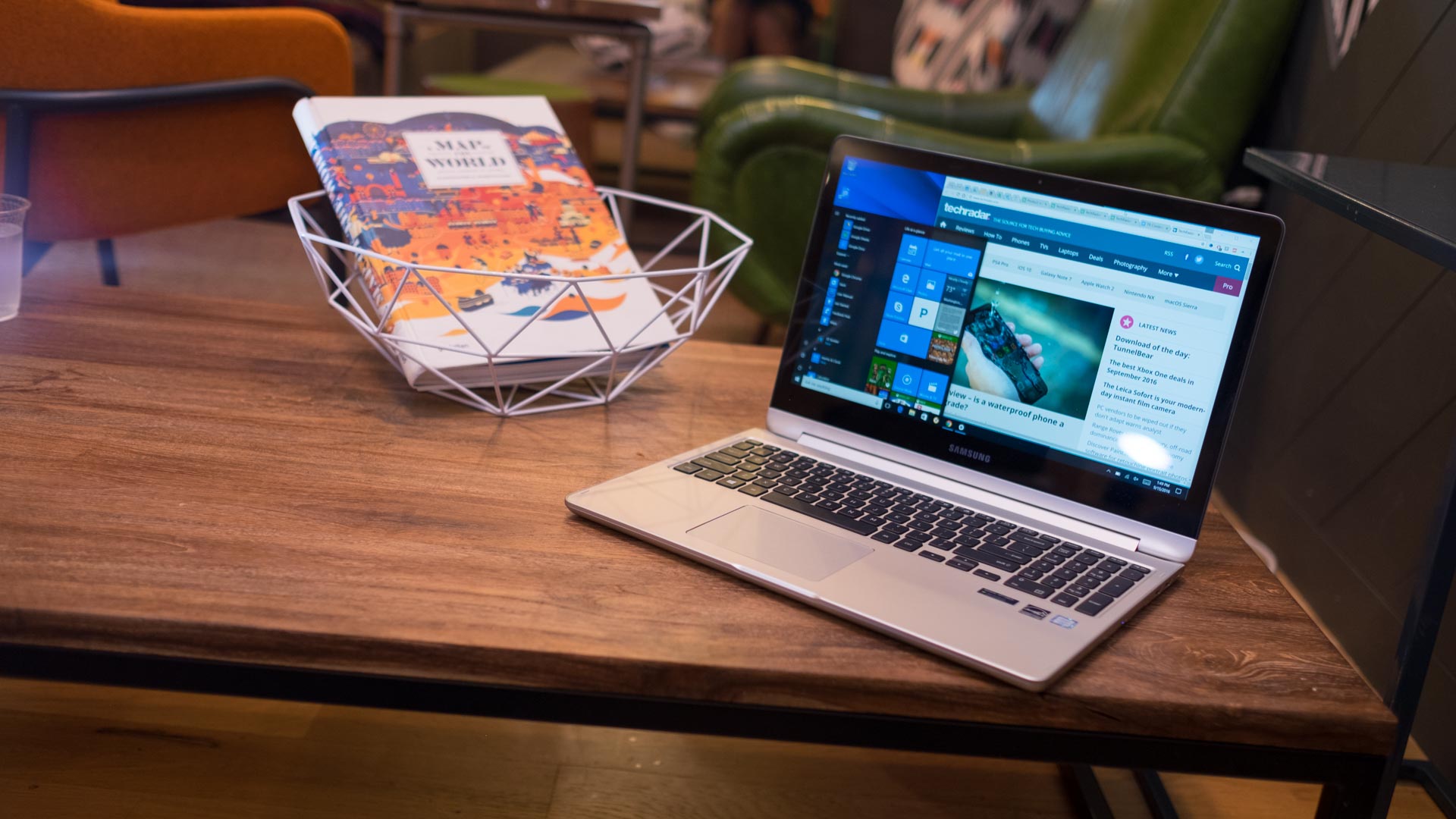Why you can trust TechRadar
For what it's worth, Samsung has built a rather thin – albeit a little dense – 15-inch laptop, with the Notebook 7 Spin weighing 5 pounds (2.26kg) on the nose and measuring 0.78 inches (19.8mm). Of course, that's not quite as thin as, say, LG's new Gram line.
The phone maker's 15-inch laptop, simply the LG gram 15, weighs less than half that and is more than a tenth of an inch thinner. (Apple's 15-inch MacBook Pro is just slightly thinner and half a pound lighter than Samsung's laptop.)
However, keep in mind that neither of these leading laptops have touchscreens, which adds to the weight. At any rate, let's see what else Samsung crammed into this machine.

Here is the Samsung Notebook 7 Spin configuration sent to TechRadar for review:
Spec sheet
- CPU: 2.5GHz Intel Core i7-6500U (dual-core, 4MB cache, up to 3.1 GHz with Turbo Boost)
- Graphics: Nvidia GeForce 940MX (2GB DDR3L); Intel HD Graphics 520
- RAM: 16GB DDR4 (2 x 8GB, 2,133MHz)
- Screen:15.6-inch Full HD (1,920 x 1,080) LED with touch panel
- Storage: 1TB HDD (SATA3); 128GB SSD (operating system; M.2)
- Ports: 1 x HDMI-out, 1 x USB-C, 1 x USB 3.1, 2 x USB 2.0, 3-in-1 SD card reader, headphone/mic jack, RJ-45 adapter
- Connectivity: 802.11ac (2 x 2 antenna) Wi-Fi, Bluetooth 4.1
- Camera: 480p webcam with dual array microphones
- Weight: 5 pounds (2.26kg)
- Size: 14.74 x 10.11 x 0.78 inches (374.5 x 256.9 x 19.8mm; W x H x D)
The arrangement you see above is one of two Samsung has made available for the 15-inch version of the Notebook 7 Spin. (There is also a more portable but underpowered, 13-inch variety available.) As of this writing, this mobile machine goes for $1,099 (about £833, AU$1,476).
Samsung's more approachable, 15-inch Notebook 7 Spin cuts the available memory by 4GB, axes the 128GB solid-state drive and … that's it, for $899 (about £681, AU$1,206) as of this writing. Those aren't exactly huge sacrifices to save 200 bucks, making this a pretty excellent value.
Meanwhile, you'll spend $1,500 (about £1,137, AU$2,012) to get an Intel Core i7 chip into the LG gram 15 and half as much total storage, no dedicated graphics and half the RAM. Of course, it all depends on what is important to you, as we quite loved the Gram.
Sign up for breaking news, reviews, opinion, top tech deals, and more.

Simply put, the Notebook 7 Spin is one of the best values we've seen in a 15-inch laptop. To really rub it in, the albeit shinier, sharper MacBook Pro would cost nearly three times as much to offer a Core i7 processor, match the amount RAM offered by Samsung and achieve comparable graphics performance.
If you're focused on getting as much as possible out of as little as possible, it's kind of (surprisingly) a no-brainer.
Performance
Considering this is designed to bring the style and power of premium laptops to a more approachable space, it's tough to challenge this device with realistic everyday tasks. The Notebook 7 Spin easily handles web browsing across 10 more Google Chrome tabs, with a web chat app and FTP client actively working – and those tabs include streaming video.

Now, don't expect to play the next Call of Duty (but maybe the new World of Warcraft expansion) on this laptop without seriously lowering your expectations. This is by no means a gaming laptop, but the Nvidia graphics make it a fine big-screen Hearthstone device. And, the graphics chip makes video streaming and Flash-based web gaming apps, like Roll20, smooth as butter.
Benchmarks
Here's how the Samsung Notebook 7 Spin performed in our suite of benchmark tests:
- PCMark 8 Home: 2,659 points
- 3DMark Cloud Gate: 6,072 points; Sky Diver: 5,166 points; Fire Strike: 1,364 points
- Geekbench Single-Core: 3,245 points; Multi-Core: 6,014 points
- Cinebench CPU: 254 points; OpenGL Graphics: 49 fps
- The Division (1080p, Ultra): 6 fps; (1080p, Low): 18 fps
- GTA V (1080p, Ultra): 9 fps; (1080p, Low): 28 fps
- PCMark 8 Battery: 4 hours and 4 minutes
These figures indicate some speedy, reliable performance from Samsung's top-level 15-incher, and on that it delivers with aplomb. The Fire Strike score of nearly 1,400, coupled with the nearly-playable frame rate in the lowest possible Grand Theft Auto V settings, tell us that this thing can play some games (and that GTA V is very well optimized). Just not too many, is all.
Your web browsing experience will be just fine – if you're on Chrome, just watch your tab count. Streaming video will be a breeze, too, both thanks to the Core i7 processor and 802.11ac Wi-Fi working in tandem.
You'll be hard pressed to stress this thing with your basic workload, even if that involves several browser tabs, high-bitrate audio streaming and a constantly-updating chat app. Again, it's remotely intense games that will most likely buckle this laptop.

To put it all in perspective, however, the LG gram 15 performed markedly worse for its slightly weaker processor, half the RAM and lack of dedicated graphics.
Battery life
Samsung promises up to 9 hours on a single charge from its Notebook 7 Spin, though our tests didn't come exactly close to that, as per usual across all of our reviews. Whereas our PCMark 8 run rated the device for just over 4 hours of lasting time, our own local video playback test had the laptop last for 5 hours and 54 minutes.
Now, considering that the notebook's fast-charging battery can regain 2 hours of its capacity in just 20 minutes, and a full charge in 90 minutes time, that's not bad battery life at all. If the laptop can get you through most domestic US flights, at this size no less, that's commendable in our book.
One dynamo of a display
While the Notebook 7 Spin's screen may only put out 1080p picture, Samsung made sure to future-proof it as much as possible with toggleable high dynamic range (HDR) technology. The LED screen, already sharp and bright at 250 nits, allows for more of the sRGB color spectrum to be displayed for better defined dark scenes and more nuanced, realistic colors in games and streaming video that support the tech.
That said, our less-than-discerning eyes couldn't tell a massive difference between video with and without HDR enabled – by pressing the Function key + F10 – save for a slightly cooler color temperature. Someone that watches a lot of, say, Daredevil on Netflix, might notice a more apparent difference here.

(An HDR photo of a gorgeous lake before a mountainside put it into better perspective, with blues in the cloud cover gaining and losing depth and nuance with HDR on and off, respectively.)

The issue here is that only YouTube offers streaming HDR content to PCs so far. Even then, the content needs to have been created with HDR-ready equipment to deliver the wider color gamut and contrast.
But, as this screen technology invades more of these devices, it's only a matter of time. Until then, you can enjoy slightly deeper and more vibrant colors as well as more nuanced contrast throughout your use of Windows 10 – especially if you work in HDR content creation.
For streaming videos and movies that specifically make use of this HDR screen, you're going to have to wait.
At any rate, the ability to position this screen in any of the standard "yoga" configurations as well only sweetens the deal. (Though, using a 15-inch, 5-pound tablet with keys on the back? We're good.)
Current page: Specifications, performance and features
Prev Page Introduction and design Next Page Verdict
Joe Osborne is the Senior Technology Editor at Insider Inc. His role is to leads the technology coverage team for the Business Insider Shopping team, facilitating expert reviews, comprehensive buying guides, snap deals news and more. Previously, Joe was TechRadar's US computing editor, leading reviews of everything from gaming PCs to internal components and accessories. In his spare time, Joe is a renowned Dungeons and Dragons dungeon master – and arguably the nicest man in tech.
